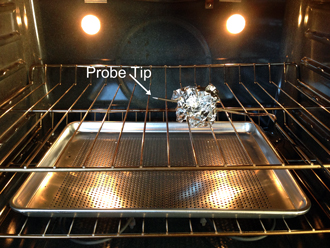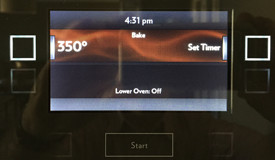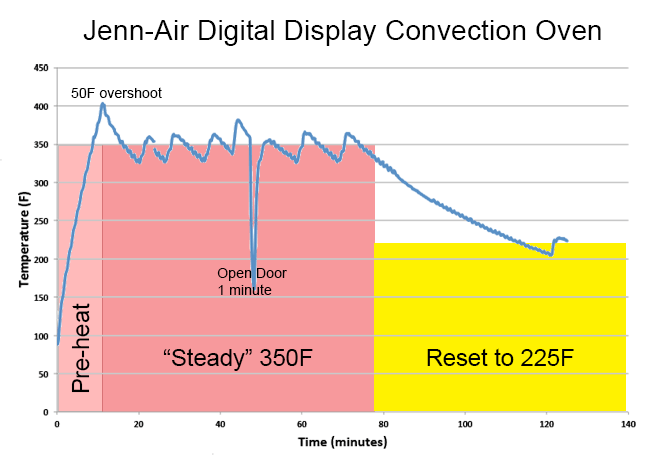| g e n u i n e i d e a s | ||||||
 |
 |
 |
 |
 |
 |
 |
| home | art and science |
writings | biography | food | inventions | search |
| how hot is it? | ||||
|
Dec 2012
How hot is it?
But exactly how hot IS it in your oven1? Can you trust the dial, or for that matter, any recipe which calls for a precise choreography of temperatures? Is a convection oven hotter than the same oven merely set to "bake"? To master your cooking equipment, a bit of experimentation and a few computer simulations will suffice. The effort will be rewarded with more consistent baking, as well as the ability to adjust new recipes to match your kitchen's personality. A typical electrica oven2 consists of an insulated metal box, heated by a metal bar (often "C" shaped) floating just above the oven floor. Electricity surges through this bar, which heats up in response to the current. Because the metal bar is highly resistive, the moving electrons bang into the metal atoms, converting their electrical motion into heat. The heating "element" glows deep red when on- around 1200F- transmitting its energy to the oven partly by warming air in direct contact with the bar, and partly by radiation of light (the same way your face is warmed by direct sunlight). Heat flows from the element, to the air, to the food, to the oven walls, and finally out into the kitchen. Most ovens are not perfectly sealed, so a bit of hot air leaks out as well, carrying enticing odors throughout the house. The heating bar cycles on and off, trying to maintain a constant temperature within the oven. Basically, the element turns on whenever the oven's heat losses (through the air and walls) falls below some limit. Just like the thermostat in your house. And just like the thermostat in your house, one part of your home may be hot while another corner is bone-chilling. Which leads to the first oven kitchen science lesson- the temperature INSIDE you oven depends on the location of the thermostat relative to the oven walls, and amazingly, relative to your food! Here is some actual data taken in the center of a Viking oven3 set to 350F, with and without a cookie sheet placed on the bottom shelf:
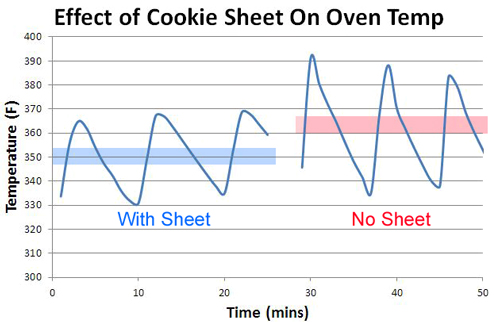
First, notice how the oven temperature (the blue curves) varies as the thermostat clicks on and off - you may hear a clicking sound or notice the oven light blink on and off, as it cycles. The thermostat triggers at the bottom of the "saw-tooth" curve, directing electricity to the bar to prevent further cooling. The bar heats up, but it takes some time for the heated air to reach the thermostat. This delay is critical. Once the thermostat realizes the oven is now warm again it turns off- but even off, the warm steel bar keeps heating the air for a few minutes (called "over-shoot"). So the oven sloshes back and forth in an effort to maintain a semblance of equilibrium4. It's very common to measure a 30F or greater fluctuation during a single cycle. But also notice how the AVERAGE oven temperature (the blue or pink bars) changed-- removing the cookie sheet raised the oven temperature by 12F! And how the temperature fluctuations INCREASED to more than 55F. How is this possible? Well, the thermostat (a mechanical temperature switch, or its more sophisticated electrical cousin, a thermocouple sensor), is generally located in the upper corner of the oven. It does not measure the AVERAGE oven temperature, or even the temperature near the food. It simply measures the temperature at one point in a vast steel box. When you place the cookie sheet on the bottom shelf, the pattern of convecting, rising hot air is disturbed (see image to right). In this case, less hot air reached the thermostat, so it thought the oven was colder, and increased the heater current in response. So the average oven temp rose.
But sometimes the oven temperature will drop instead of rise, depending on the placement of the cookie sheet. You may have noticed this effect at home- if you close the curtains on a window near a thermostat, the house temperature drops because the thermostat is no longer cooled off by cold wind currents emanating from the glass panes. The thermostat now "feels" warmer, so it doesn't need to switch the furnace on as frequently, thus cooling the bulk of your house. Yet few recipes take the internal arrangement of the oven into account. Which is understandable. Few people are aware of this phenomena, and even if they were, the effect is oven-model dependent. Which leads to our second observation- every oven is different, and you need to adjust every baking recipe to match the peculiarities of your equipment. For example, many recipes today involve starting cooking at one temperature and, after a few minutes, dropping to a second, lower temperature (Cooks Illustrated is particularly fond of this approach). For example, to first sear and then to more uniformly bake (see this article on Prime Rib). The problem is, not every oven leaks heat out at the same rate. For example, this data compares a Viking oven to a Whirlpool Accubake, when the oven was turned down from 450F to 350F: In addition to the now familiar "saw-tooth" oven fluctuations and the fact that neither oven actually maintained 450F on a 450F setting, note the Viking took twice as long to cool off. Not a problem when slow roasting for hours, but an issue if the recipe calls for a total of 45 minutes in the oven. And not every baking sheet is the same. Some are thick, some are thin. Some black, some silver. Some rimmed, some insulated. Do any of these choices make a difference? The answer is yes, and unfortunately for the home cook, each kind of sheet is best suited for particular recipes. To see why, let's compare baking a slab of cookie dough on a flat versus a rimmed cookie sheet. In this case, I'm "cooking" inside a computer simulated oven (which allows us to follow the flow of normally invisible hot air)5. As in many recipes, we removed the cookie dough and cookie sheet from the fridge just before baking- this helps prevent spreading. But what happens in the oven is fascinating: The hot oven air is immediately cooled by the dough and sheet- this cold air (blue in the simulation) falls to the bottom of the oven and courses off the sides of the cookie sheet. But it is also trapped by the rimmed tray, like fog in a cold mountain valley. This ensures the cookies on the rimmed sheet are a bit colder than on the unrimmed- it also traps some of the evaporated moisture, increasing the local humidity. A cookie micro-climate. Much of the cold energy leaves the cookie by direct conduction from the dough through the metal sheet, as a waterfall of descending cold air. This is why an insulated cookie sheet prevents burning but slows down cooking- it prevents the heating element's hot radiation from reaching the cookies, but also blocks cold air from the cookie from mixing in the oven. Watch these two movies of the simulated oven (you can click on both videos so they run in parallel). It follows the first five minutes of cooking, tracing the the heat flow on a vertical plane through the middle of the oven. The cool microclimate surrounding each tray is visible, as is a cross-section of the heating element which turns on once or twice. The rimmed sheet holds onto a bubble of cold air longer, and the cookies take a few minutes more to cook.
Now, some baked goods- particular chewy cookies, benefit from a slow, more humid environment. So choose a rimmed baking pan or even an insulated cookie sheet to prevent browning and maintain a high, local humidity. Other cookies benefit from a hotter, drier oven, so choose a black rimless sheet that absorbs the infra-red energy and allows the cookie's cold air to flow away. Beware of recipes that lack specifics when it comes to the type of sheet, and its position in the oven. For some, these observations may prove useful, but for most home cooks, all this variability is worrisome. Is there a way to eliminate the hot and cold spots, enabling the thermostat to work more reliably? A simple, and inexpensive solution is to simply blow air around within the oven with a fan. Which is all a convection oven actually does, but there are a few myths worth dispelling. Convection ovens are neither hotter or colder than a regular oven. It's the same oven air at the same temperature in either case. But, a fan blows away cold drafts emanating from the cookie sheet, mixing it with the hot air from the walls and heater, and sending what is now an averaged temperature air at the thermostat. The convection oven might run hotter OR colder than the "baking" setting, depending on whether the baking oven diverted more or less hot air to the thermostat. In the example below, this Viking oven runs hotter (by 5F) on the baking setting compared to the convection setting. More importantly, the fluctuations within a cycle are reduced in half. So the temperature is more uniform in time with convection- important for certain recipes and not others. The cycle time, which is set by the thermal losses through the oven's walls, is unchanged: The main difference between convection and conventional baking is one of humidity. Just like a fan cools and dries sweat off on a hot summer day, the fan in the convection oven cools and dries off food. Often this speeds up the cooking process, and gives the appearance of higher temperatures with convection. By drying the surface, convection browns faster. But in fact, the oven temperature is unchanged. Based on these experiments, simulations, plus a few decades in the kitchen, here are my suggestions:
Will these suggestion make you a better cook? They certainly will improve anyone's baking skills (where precision matters), and will even help a bit when cooking meats for long times. An oven is a simple tool, once you expose its secrets. |
||||
|
-------------------------------------------------------------------------------------------------------- Additional articles on kitchen science can be found HERE. 1How to measure oven temperature: First, insert a wire shelf in the very bottom of the oven, and place a cookie sheet in the middle of the rack. Place a second shelf in the middle position. Then, ball up a square of aluminum foil, and insert the thermometer probe through the wad so it protrudes at least an inch (do not use a potato as the probe holder- it will form a cool micro-climate and throw off the measurement). Snake the cord out of the oven, and turn on the thermometer. Now comes the hard part. Turn the oven to 400F. Let it pre-heat for an hour. Because of the saw-tooth temperature cycling, you simply can't record one temperature after pre-heating, as "the" oven temp. Instead, record the temperature when the oven cycles on (this is the lowest temp it will reach), and then watch the digital display and record the highest temperature. Average the two and compare to 400F. Repeat at 325F and 225F, waiting at least a half hour between measurements for the oven to stabilize. Most ovens are designed to be their most accurate in the 350F range, which is where most cooking occurs. So don't be surprise if the oven is off by 50F at the low end. If your oven has a digital readout, you can keep a chart near the oven and interpolate between these measurements to know how much to offset the oven settings to achieve the proper temperature. If you have a mechanical thermostat, wrap some tape around the knob and mark the correct temperatures (a few manufacturers actually incorporate an adjustment screw so the entire knob can be offset by a fixed amount- but these ovens are rare, and in any case, the ideal correction is often not a simple offset). 2Gas ovens are similar to electric. Both contain a thermostat and a heating bar. However, in this case the heating element is a perforated tube emitting gas flames from the sides. Unlike an electric oven, the gas heating bar is usually placed under a metal plate with slots along the edges, to protect the cook from direct flames. The oven also tends to leak air at a higher rate, to assure the flames have sufficient oxygen available to burn efficiently. Thus gas ovens often exhibit even wider temperature fluctuations than electric ovens. See this excellent video describing their operation. 3Quis custodiet ipsos custodes? Not all digital thermometers are accurate- some are off by more than 10F. To calibrate your corded digital oven thermometer, test at two temperatures. First (assuming you are at sea level so the boiling point of water is 212F), hold the tip of the probe in the middle of a pot of gently boiling water. It should read 212F (210 or 214F is fine). Then, put crushed ice and water in a thermos. Shake and let sit for a half hour hour. Plunge the thermometer in the cold ice slurry- it should read 32F (34F also fine). Replace with a new or better model if it fails. 4How to build a better oven: The only thing worse than a home kitchen oven is a toaster oven. Commercial ovens are much more uniform than home appliances- they employ rotating shelves to homogenize the air temperature, they mask the heating elements behind a permanent barrier to block infra-red light, and most importantly, discard the simple on/off thermostat in favor a PID. A PID modulates the heater continuously, rather than abruptly switching on and off. It can predict future heat losses to avoid overshoot. A PID can hold the temperature constant + 2F, over any temperature range. PIDs are used in sous vide baths to accurately control water temperature to a fraction of a degree. A digital display, by itself, does NOT mean the oven performs better than a simple thermostatic dial. For example, this modern Jenn Air has a digital display that tracks the oven temp as it heats up (or drops when opened). It *appears* to be remarkably precise. And accurate.
I set the oven to 350F and to 225F, and in both cases the controller accurately maintained this AVERAGE temp. Which is better than the +25F error common in many dial thermostatic ovens. But, as you can see from this chart, the oven is not PID controlled- it overshoots by 50F on preheating, and oscillates around the average by +15F every ten minutes, and a few additional degrees once a minute as the convection fan cycles.
PIDs are uncommon in home ovens due to cost- they add more than $200 to the retail price. But, its a shame high end ovens which cost a few thousand dollars put most of the money into stainless steel rather than the controller. Of course, for many people the oven is an objet d' art, and not a practical appliance, so perhaps they know what they are doing. 5A note about these simulations: The oven was modelled using CD-Adapco CFD software implementing standard Navier-Stokes, Fickes Law and black body equations (among others). The heater generates around 3KW, and the oven leaks air at about one to two full volume exchanges per hour. As you can see from this comparison, the model closely matches the behavior of a typical real-world oven. However, it only approximately handles the effect of evaporative cooling on food, which is most important at low temperatures and for longer cooking times. A new, more complete model is in being tested and we will update this article soon. |
||||
 Contact Greg Blonder by email here - Modified Genuine Ideas, LLC. |

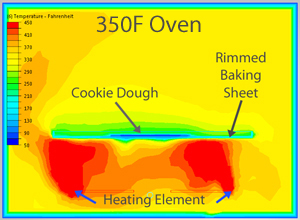 The cookie sheet also blocks the heating element's infra-red light from directly illuminating the thermostat (just like a simple sheet of newspaper can block the scorching heat radiated from a fireplace). Remove the cookie sheet, and this infra-red light impinges on the thermostat, causing it to swing on and off more wildly.
The cookie sheet also blocks the heating element's infra-red light from directly illuminating the thermostat (just like a simple sheet of newspaper can block the scorching heat radiated from a fireplace). Remove the cookie sheet, and this infra-red light impinges on the thermostat, causing it to swing on and off more wildly.